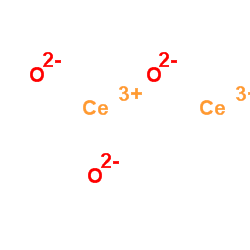Related compounds Molar mass 328.24 g/mol Density 6.2 g/cm³ | Formula Ce2O3 Melting point 2,177 °C Appearance | |
 | ||
Cerium(III) oxide, also known as cerium oxide, cerium trioxide, cerium sesquioxide, cerous oxide or dicerium trioxide, is an oxide of the rare earth metal cerium. It has chemical formula Ce2O3, and is gold-yellow in color.
Contents
Engine and exhaust catalysts
Cerium oxide is used as a catalytic converter for the minimisation of CO emissions in the exhaust gases from motor vehicles.
When there is a shortage of oxygen, cerium(IV) oxide is reduced by carbon monoxide to cerium(III) oxide:
2 CeO2 + CO → Ce
2O
3 + CO
2
When there is an oxygen surplus, the process is reversed and cerium(III) oxide is oxidized to cerium(IV) oxide:
2 Ce2O
3 + O
2 → 4 CeO
2
Major automotive applications for cerium(III) oxide are, as a catalytic converter for the oxidation of CO and NOx emissions in the exhaust gases from motor vehicles, and secondly, cerium oxide finds use as a fuel additive to diesel fuels, which results in increased fuel efficiency and decreased hydrocarbon derived particulate matter emissions, however the health effects of the cerium oxide bearing engine exhaust is a point of study and dispute.
Water splitting
The cerium(IV) oxide–cerium(III) oxide cycle or CeO2/Ce2O3 cycle is a two step thermochemical water splitting process based on cerium(IV) oxide and cerium(III) oxide for hydrogen production.
Illumination
Cerium(III) oxide combined with tin(II) oxide (SnO) in ceramic form is used for illumination with UV light. It absorbs light with a wavelength of 320 nm and emits light with a wavelength of 412 nm. This combination of cerium(III) oxide and tin(II) oxide is rare, and obtained only with difficulty on a laboratory scale.
Production
Cerium(III) oxide is produced by the reduction of cerium(IV) oxide with hydrogen at approximately 1,400 °C (2,550 °F) to make air stable cerium(III) oxide.
